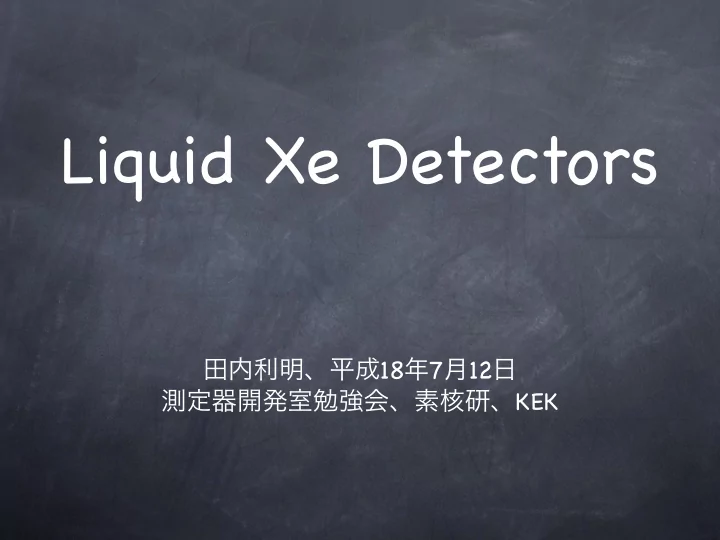

Liquid Xe Detectors 田内利明、平成 18 年 7 月 12 日 測定器開発室勉強会、素核研、 KEK
General Property of Liquid Xenon http:/ /www.pd.infn.it/~conti/LXe.html Rich detection media : Scintillation and Ionization Scintillation Ionization energy position photomultipliers ionization chamber with low noise amp. 300e GEM/photocathod GEM in 2 phase Xe Avalanche Photodiodes 22,000 VUV photons/511KeV with 3ns, 27ns and 45ns 30,000 electron-ion pairs/511KeV electron drift at 2.3mm/us with 2kV /cm At 511 keV, 22% photoelectric, 78% Compton with xenon half a mm for 511 keV photoelectron Primary ionization signal is weak: of the order of 1, 10, 100 and 500 keV for coherent neutrino, dark matter, solar neutrino and PET respectively.
XENON (PSD and Scint/Ion) Xe + three discrimination techniques Ionisation +Xe Nuclear/Electron Recoil + Xe 2 (1) scintillation pulse shape Excitation +e - (2) ionisation-scintillation (recombination) - low field- Xe * Xe ** + Xe +Xe (3) ionisation-scintillation - high field, low threshold - * Xe 2 175nm 175nm single phase Xe Triplet Singlet two phase Xe 3ns 27ns ga s 2Xe 2Xe liqui liqui d d World expertise • ICARUS-UCLA • Doke group (Japan) • DAMA • Columbia • UKDMC • ITEP Neil July
Table 1.5: Physical properties of noble liquids (adapted from Ref. (98)). LAr LKr LXe Atomic Number Z 18 36 54 Atomic Weight A 39.95 83.8 131.3 Density (g/cc) 1.39 2.45 3.06 Melting Point T m (K) 83.8 115.8 161.4 Boiling Point T b (K) 87.3 119.8 165.1 Critical Temperature T c (K) 150.7 209.5 289.7 Critical Pressure P c (atm) 48.3 54.3 57.64 Critical Density (g/cc) 0.54 0.91 1.10 Volume Ratio ( ρ l / ρ g ) 784 641 519 Fano Factor 0.107 0.057 0.041 Drift Velocity (mm/ µ sec) @ 1(5) kV/cm 1.8(3.0) 2.4(4.0) 2.2(2.7) Mobility (cm V − 1 s − 1 ) 525 1800 2000 Radiation Length (cm) 14.3 4.76 2.77 (dE/dx) (MeV/cm) 2.11 3.45 3.89 Liquid Heat Capacity (cal/g-mole/K) 10.05 10.7 10.65 W-value (eV) (ionization) 23.3 18.6 15.6 W-value (eV) (scintillation) 19.5 15.5 14.7 Wavelength of Scintillation Light (nm) 130 150 175 Decay const. fast (ns) 6.5 2 2 slow (ns) 1100 85 30 Refractive index @ 170 nm – 1.41 1.60 Dielectric constant 1.51 1.66 1.95
1 Phase
EXO TPC ; 1 phase 2006 http:/ /www-project.slac.stanford.edu/exo/ ; Double β Decay liqXe-TPC, grid and segmented anode and PMT, 10ton (3m 3 ) WIPP : Waste Isolation Pilot Plant Carlsbad NM, Excavated in underground salt – lower U/Th activity. ~2,000 m.w.e. depth 200kg (63l), enriched 136 Xe (80%) 2006 without Ba tagging for 2 years 1 ton with Ba tagging for 5 years 10 ton with Ba tagging for 10 years 136 Xe → 136 Ba ++ + e – + e – • Extract the Barium ion from the event location (electrostatic probe) • Deliver the Barium to a laser system for Ba 136 identification.
Xe offers a new tool to reduce background: 136 Xe 136 Ba ++ final state can be identified using optical spectroscopy (M.Moe PRC44 (1991) 931) Ba + system best studied (Neuhauser, Hohenstatt, Toshek, Dehmelt 1980) Very specific signature “shelving” Single ions can be detected from a photon rate of 10 7 /s Barium tagging would eliminate all radioactive backgrounds, leaving only 2 νββ . TPC Symposium 2003 The Enriched Xenon Observatory 7
It’s just crazy enough to work Assuming that the Xe chamber + Ba tagging reduce to 0 all radioactive background... Isotope Det mass Enrich. Eff. Measur. Background T 1/2 0 νββ <m n > (eV) (kg) (%) (%) time (yr) (yr) QRPA NSM 136 Xe * 1000 80 70 5 0 + 1.8 events 8.3*10 26 0.051 0.14 136 Xe ** 10000 80 70 10 0 + 5.5 events 1.3*10 28 0.013 0.037 * σ (E)/E = 2.8% R.Luescher et al. Phys. Lett. B434 (1998) 407 ** σ (E)/E = 2.0% Modest improvement on the above. The meV region is within reach. TPC Symposium 2003 The Enriched Xenon Observatory 8
�������� ����������� ���������� ������� ������ ����������������������������������� ���������������������������������� ����� ����������������������� ����������������������� ����� ����� ��������������������� ��������������������� ����� ����� ��������������������� ��������������������� ��������������������� ��������������������� ��������������� �������� ��� ��� ������� �������������������������� �������������������������� ������������ ������ ��
����������������������������������� ������������������� ������ ����������� ��� ����� �������� ����� ��������
���������������� � ������������������������� ������������������������� ������������� � �������������������������������� �� ������������������ spatial resolution � ���������������� ��������������� 1 -2cm ���������������������� ������������ ������� � ������ ��������������������������� ����� ��������������������� � ���������������������������� �������� �� � ����� �������������� � �������������������������������� � ����������������������������� ����� for lights ���������������������� ������������ ������ ��
Xenon calorimetry We measure the event energy by collecting the ionization on the anode and/ or observing the scintillation. As the electric field is increased, the collected ionization increases and the scintillation decreases. TPC Symposium 2003 The Enriched Xenon Observatory 12
����������������������������������������� ����� �������� �������� ������������������������������������ ��������� ������ ������������ �������������������� �������������������� ������������������������� ������������������������� ������ ������ ����������������� ����������������� ����������� ����������� ������������ ������ � ������������������� �������������������
An experimental facility for EXO WIPP : Waste Isolation Pilot Plant Carlsbad NM Excavated in underground salt – lower U/Th activity. ~2,000 m.w.e. depth Charles Prescott - SLAC Neutrino Day - April 18, 2003
http:/ /www-sk.icrr.u-tokyo.ac.jp/xmass/;for Solar ν , 2 β , DM 2004 Strategy of the XMASS project ; 1 phase Strategy of the XMASS project NOW ~1m ~2.5m ~30cm ~1 ton detector ~20 ton detector (FV 100kg) Prototype detector (FV 10ton) 100kg Dark matter search (FV 3kg) R&D Solar neutrinos Confirmation of feasibilities Dark matter search of the ~1 ton detector Analysis techniques Self shielding performance Dedicated detector for Low background properties Double beta decay search Purification techniques August 18, 2004 Y.Takeuchi @ICHEP04 in Beijing
Recommend
More recommend